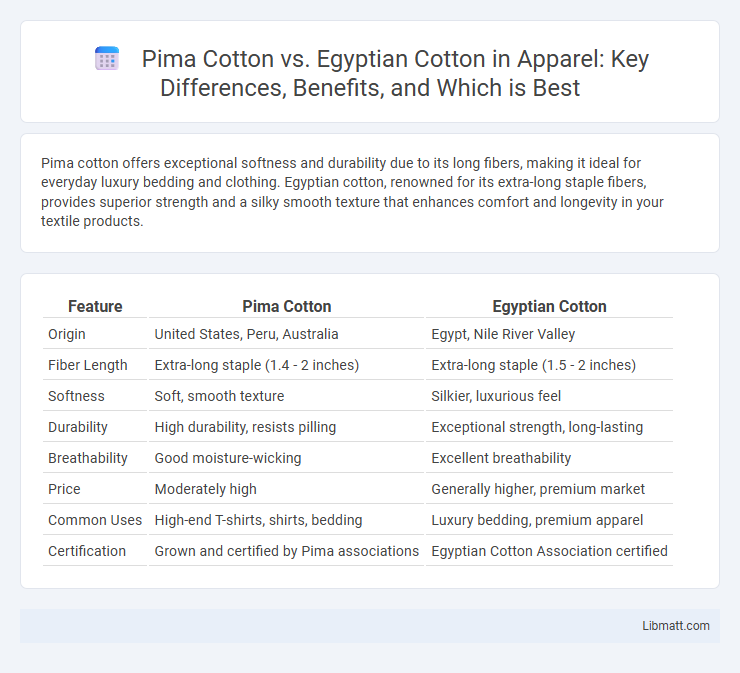Pima cotton offers exceptional softness and durability due to its long fibers, making it ideal for everyday luxury bedding and clothing. Egyptian cotton, renowned for its extra-long staple fibers, provides superior strength and a silky smooth texture that enhances comfort and longevity in your textile products.
Table of Comparison
| Feature | Pima Cotton | Egyptian Cotton |
|---|---|---|
| Origin | United States, Peru, Australia | Egypt, Nile River Valley |
| Fiber Length | Extra-long staple (1.4 - 2 inches) | Extra-long staple (1.5 - 2 inches) |
| Softness | Soft, smooth texture | Silkier, luxurious feel |
| Durability | High durability, resists pilling | Exceptional strength, long-lasting |
| Breathability | Good moisture-wicking | Excellent breathability |
| Price | Moderately high | Generally higher, premium market |
| Common Uses | High-end T-shirts, shirts, bedding | Luxury bedding, premium apparel |
| Certification | Grown and certified by Pima associations | Egyptian Cotton Association certified |
Overview of Pima Cotton and Egyptian Cotton
Pima cotton, known for its extra-long staple fibers, offers exceptional softness, durability, and breathability, primarily grown in the United States, Peru, and Australia. Egyptian cotton, originating from the Nile River Valley, is prized for its superior fiber length and strength, producing luxurious, smooth, and highly absorbent fabric favored in premium bedding and textiles. Both types rank among the highest quality cottons globally, but Egyptian cotton is often regarded as the finest for luxury products due to its ultra-fine fiber characteristics.
Historical Origins and Background
Pima cotton, developed in the early 20th century in the United States, was named after the Pima Native Americans who first cultivated this extra-long staple cotton. Egyptian cotton has a longer historical lineage, dating back to ancient Egypt, renowned for its superior fiber quality due to the Nile River's ideal climatic conditions. Both cotton varieties have become synonymous with luxury textiles, prized for their strength, softness, and durability.
Key Differences in Cotton Fiber Quality
Pima cotton features extra-long staple fibers averaging 1.4 inches, resulting in a soft, durable fabric with less pilling compared to standard cotton. Egyptian cotton boasts even longer fibers, often exceeding 1.5 inches, contributing to its luxurious smoothness and superior strength. When choosing between the two, your preference for softness versus durability will guide the optimal selection for high-quality textiles.
Growing Regions and Climate Influence
Pima cotton primarily thrives in the southwestern United States and parts of Peru, where the warm, arid climate promotes long fiber growth, resulting in exceptional softness and strength. Egyptian cotton is cultivated mainly along the Nile River Valley, where the unique combination of rich soil and optimal irrigation creates extra-long fibers that enhance durability and luxury. Understanding the distinct growing regions and climate influences helps you choose between these premium cotton varieties based on quality and performance preferences.
Softness and Feel Comparison
Pima cotton offers a plush, velvety softness with its extra-long staple fibers, making it exceptionally smooth and durable. Egyptian cotton, prized for its luxurious silky texture, provides a lightweight and breathable feel that enhances comfort. Your choice between the two depends on whether you prefer the thick, cushy softness of Pima or the elegant, airy smoothness of Egyptian cotton.
Durability and Longevity
Pima cotton offers exceptional durability due to its extra-long staple fibers, making it resistant to pilling and wear over time. Egyptian cotton, known for its fine and long fibers, provides a soft texture while maintaining strong tensile strength, ensuring long-lasting fabric quality. Both types excel in longevity, but Pima cotton typically endures more abrasion, making it ideal for high-use textiles.
Price Differences and Market Value
Pima cotton generally commands a higher market value than Egyptian cotton due to its longer staple fibers, which contribute to greater durability and softness. Price differences are influenced by rarity and production costs, with Egyptian cotton often priced lower because of its wider availability and variations in fiber quality. Consumers seeking luxury bedding are willing to pay premium prices for Pima cotton's consistent quality, making it more valuable in upscale textile markets.
Best Uses for Pima and Egyptian Cotton
Pima cotton is ideal for casual wear, luxury bedding, and towels due to its exceptional softness, durability, and resistance to pilling. Egyptian cotton is best suited for high-end sheets, pillowcases, and premium garments because of its extra-long staple fibers that offer superior strength and a silky feel. Both types excel in producing breathable, comfortable textiles but differ in texture and weave preferences for luxury and everyday use.
Identifying Authentic Cotton Products
Authentic Pima cotton is recognized for its extra-long staple fibers, which provide superior softness and durability, while genuine Egyptian cotton boasts similarly long fibers but is cultivated exclusively in the Nile River Valley, contributing to its unique texture and strength. To identify authentic cotton products, examine the label for certifications like the Cotton Egypt Association or Pima Cotton USA, and look for detailed origin information. Your best approach to ensure quality is to verify these indicators alongside feel and weave consistency, as many products falsely claim luxury cotton status.
Which Cotton Is Best for You?
Pima cotton offers exceptional softness and durability, making it ideal for everyday luxury bedding and clothing with long-lasting quality. Egyptian cotton, renowned for its extra-long staple fibers, provides superior breathability and a silky smooth texture, perfect for those seeking premium comfort and elegance. Your choice depends on whether you prioritize durability and softness (Pima) or moisture-wicking properties and refined softness (Egyptian).
Pima cotton vs Egyptian cotton Infographic

 libmatt.com
libmatt.com